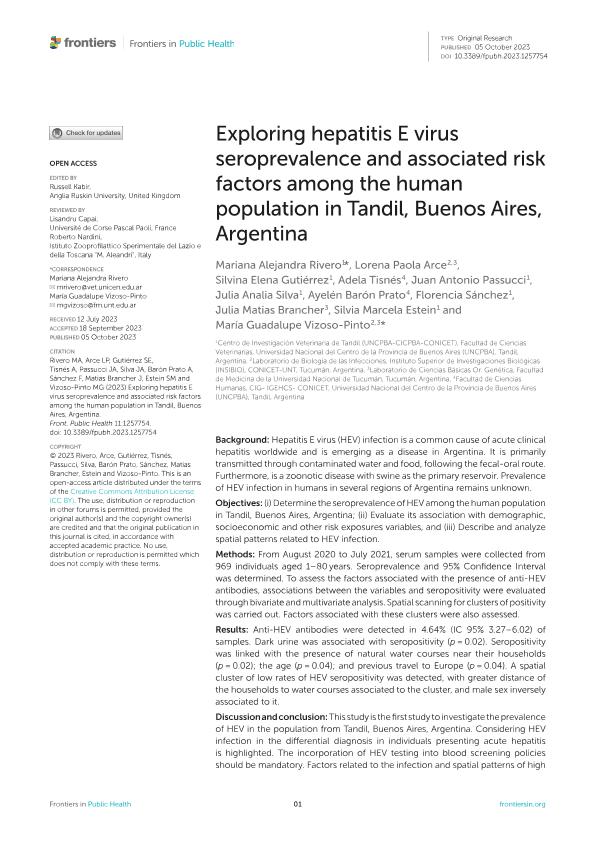Artículo
Exploring hepatitis E virus seroprevalence and associated risk factors among the human population in Tandil, Buenos Aires, Argentina
Rivero, Mariana Alejandra ; Arce, Lorena Paola
; Arce, Lorena Paola ; Gutiérrez, Silvina Elena
; Gutiérrez, Silvina Elena ; Tisnés, Adela
; Tisnés, Adela ; Passucci, Juan Antonio; Silva, Julia Analia; Barón Prato, Ayelén; Sánchez, Florencia; Matias Brancher, Julia Rafaela
; Passucci, Juan Antonio; Silva, Julia Analia; Barón Prato, Ayelén; Sánchez, Florencia; Matias Brancher, Julia Rafaela ; Estein, Silvia Marcela
; Estein, Silvia Marcela ; Vizoso Pinto, María Guadalupe
; Vizoso Pinto, María Guadalupe
 ; Arce, Lorena Paola
; Arce, Lorena Paola ; Gutiérrez, Silvina Elena
; Gutiérrez, Silvina Elena ; Tisnés, Adela
; Tisnés, Adela ; Passucci, Juan Antonio; Silva, Julia Analia; Barón Prato, Ayelén; Sánchez, Florencia; Matias Brancher, Julia Rafaela
; Passucci, Juan Antonio; Silva, Julia Analia; Barón Prato, Ayelén; Sánchez, Florencia; Matias Brancher, Julia Rafaela ; Estein, Silvia Marcela
; Estein, Silvia Marcela ; Vizoso Pinto, María Guadalupe
; Vizoso Pinto, María Guadalupe
Fecha de publicación:
10/2023
Editorial:
Frontiers Media
Revista:
Frontiers in Public Health
ISSN:
2296-2565
Idioma:
Inglés
Tipo de recurso:
Artículo publicado
Clasificación temática:
Resumen
Background: Hepatitis E virus (HEV) infection is a common cause of acute clinical hepatitis worldwide and is emerging as a disease in Argentina. It is primarily transmitted through contaminated water and food, following the fecal-oral route. Furthermore, is a zoonotic disease with swine as the primary reservoir. Prevalence of HEV infection in humans in several regions of Argentina remains unknown. Objectives: (i) Determine the seroprevalence of HEV among the human population in Tandil, Buenos Aires, Argentina; (ii) Evaluate its association with demographic, socioeconomic and other risk exposures variables, and (iii) Describe and analyze spatial patterns related to HEV infection. Methods: From August 2020 to July 2021, serum samples were collected from 969 individuals aged 1–80 years. Seroprevalence and 95% Confidence Interval was determined. To assess the factors associated with the presence of anti-HEV antibodies, associations between the variables and seropositivity were evaluated through bivariate and multivariate analysis. Spatial scanning for clusters of positivity was carried out. Factors associated with these clusters were also assessed. Results: Anti-HEV antibodies were detected in 4.64% (IC 95% 3.27–6.02) of samples. Dark urine was associated with seropositivity (p = 0.02). Seropositivity was linked with the presence of natural water courses near their households (p = 0.02); the age (p = 0.04); and previous travel to Europe (p = 0.04). A spatial cluster of low rates of HEV seropositivity was detected, with greater distance of the households to water courses associated to the cluster, and male sex inversely associated to it. Discussion and conclusion: This study is the first study to investigate the prevalence of HEV in the population from Tandil, Buenos Aires, Argentina. Considering HEV infection in the differential diagnosis in individuals presenting acute hepatitis is highlighted. The incorporation of HEV testing into blood screening policies should be mandatory. Factors related to the infection and spatial patterns of high and low risk were determined, and should be considered when implementing specific preventive measures.
Archivos asociados
Licencia
Identificadores
Colecciones
Articulos(CIVETAN)
Articulos de CENTRO DE INVESTIGACION VETERINARIA DE TANDIL
Articulos de CENTRO DE INVESTIGACION VETERINARIA DE TANDIL
Articulos(IGEHCS)
Articulos de INSTITUTO DE GEOGRAFIA, HISTORIA Y CS. SOCIALES
Articulos de INSTITUTO DE GEOGRAFIA, HISTORIA Y CS. SOCIALES
Articulos(INSIBIO)
Articulos de INST.SUP.DE INVEST.BIOLOGICAS
Articulos de INST.SUP.DE INVEST.BIOLOGICAS
Citación
Rivero, Mariana Alejandra; Arce, Lorena Paola; Gutiérrez, Silvina Elena; Tisnés, Adela; Passucci, Juan Antonio; et al.; Exploring hepatitis E virus seroprevalence and associated risk factors among the human population in Tandil, Buenos Aires, Argentina; Frontiers Media; Frontiers in Public Health; 11; 10-2023; 1-13
Compartir
Altmétricas



